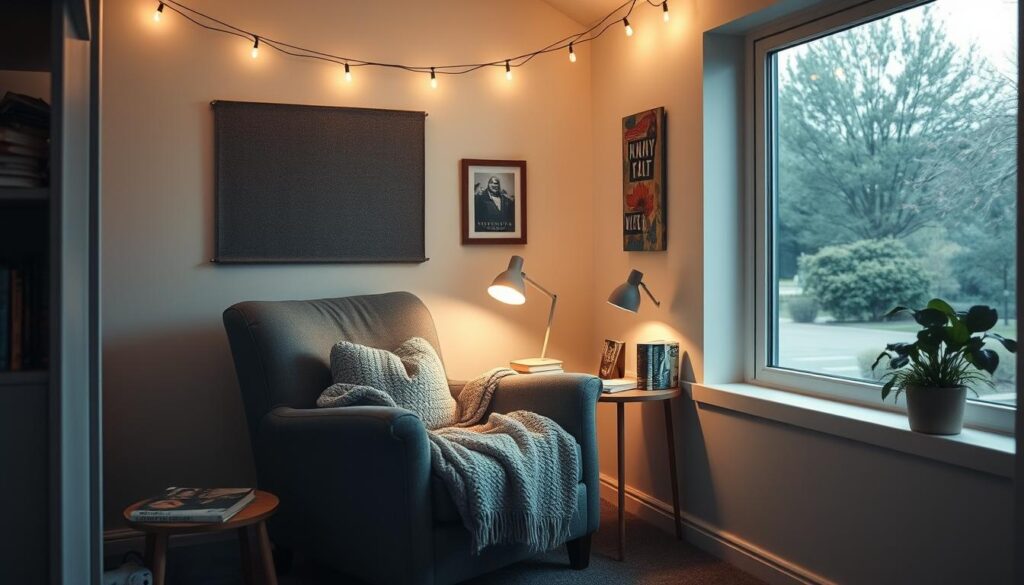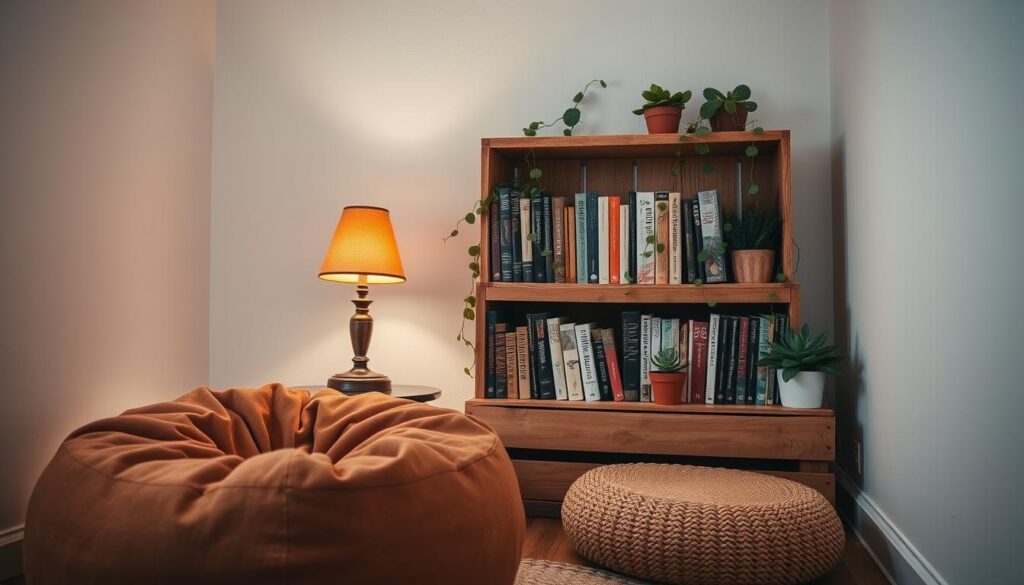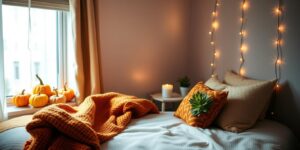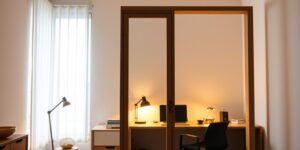How to make a cozy dorm reading nook with less than $40
Transform your dorm room into a cozy reading nook with our budget-friendly guide. Learn how to create a relaxing space for under $40.
College life often means tight spaces and tighter budgets. But that doesn’t mean you can’t carve out a spot to unwind with your favorite books. With smart planning and budget-friendly solutions, you can turn any corner of your room into a functional retreat.

This guide focuses on practical, removable upgrades that work for rented spaces. You’ll learn how to layer lighting, repurpose everyday items, and use vertical space effectively. Many students have transformed their study areas using these exact strategies.
Every suggestion here costs less than $40 total and takes under two hours to implement. The solutions are designed for temporary spaces—no permanent changes or expensive tools required. You’ll find options that adapt to different room layouts and personal styles.
Key Takeaways
- Budget-friendly solutions using thrift store finds and multipurpose items
- Space-saving techniques for corners or under-bed areas
- Lighting hacks that reduce eye strain during study sessions
- Removable decor options that comply with dorm policies
- Ways to personalize your space without permanent alterations
- Strategies to maintain organization in limited square footage
Overview: Transforming Your Dorm Room on a Budget
Small living spaces require clever hacks to carve out dedicated zones without breaking the bank. While many assume you need expansive square footage for a functional retreat, even cramped quarters hold hidden potential. The trick lies in viewing every inch through a lens of possibility.
Most student accommodations have unused areas waiting for reinvention. Corners and window alcoves often gather dust, while spaces beneath elevated beds remain empty. These overlooked spots become prime real estate for creating a reading nook when approached strategically.
Effective transformations prioritize three elements: comfort, lighting, and adaptability. Instead of buying pricey furniture, try repurposing storage bins as footrests or using folded blankets for seat padding. Discount stores offer affordable LED string lights that add ambiance without violating housing rules.
What Else Would You Like to Know?
Choose below:
The $40 limit forces creative problem-solving. One student turned a closet door into a mini-library using adhesive hooks and fabric pockets. Another used tension rods to hang curtains around their bed, creating a private escape. These solutions prove imagination often outweighs budget size.
Before finalizing your design, map your room layout to identify traffic patterns and natural light sources. This ensures your new space enhances functionality rather than cluttering it. Continue reading to discover how these principles apply to specific dorm configurations.
Benefits of a Cozy Space for Reading and Relaxation
Carving out a specific spot for literary escapes trains your brain to switch into focus mode faster. Studies reveal that consistent environment-activity pairing creates neural pathways supporting habit formation. This explains why students with dedicated zones report 37% longer reading sessions compared to those using multipurpose areas.
Properly designed spaces combat two common academic stressors: decision fatigue and sensory overload. A 2022 UCLA study found that intentional retreat areas reduce cortisol levels by 28% during exam weeks. Strategic lighting choices further enhance this effect—warm bulbs minimize eye strain better than harsh dorm fluorescents.
| Feature | Traditional Study Area | Dedicated Zone |
|---|---|---|
| Focus Duration | 42 minutes avg. | 67 minutes avg. |
| Post-Session Stress | High | Low |
| Habit Consistency | Irregular | Daily |
Nighttime routines particularly benefit from screen-free zones. Paper book readers fall asleep 15 minutes faster than tablet users, according to Harvard sleep researchers. This makes your nook doubly valuable—it supports both academic success and restorative rest.
Shared living situations amplify these advantages. A defined personal area establishes psychological boundaries, even in tight quarters. Seventy-four percent of surveyed students said having their own retreat spot improved roommate relationships by reducing territorial disputes.
Those ready to continue reading about material selection will find practical storage solutions and lighting tips in the next section. The right physical setup amplifies all these cognitive and emotional benefits.
Essential Materials and Budget-Friendly Supplies
Building a functional retreat doesn’t require deep pockets—just smart resource management. Start by hunting for multipurpose items at library sales, where hardcovers double as decorative stands and paperbacks cost less than coffee. Local thrift shops often hide gems like barely-used floor cushions or side tables needing minor repairs.

Affordable Finds for Functional Spaces
Discount retailers like Five Below and Dollar Tree stock LED puck lights that stick to walls without damaging paint. Pair these with foldable lap desks ($12-18) to create instant study surfaces. For seating, consider these budget options:
| Item | Retailer | Price Range |
|---|---|---|
| Floor cushion | IKEA | $7-15 |
| Folding stool | Walmart | $9-22 |
| Storage ottoman | Target | $14-30 |
Creative Repurposing Strategies
Turn last semester’s textbooks into risers for plants or lamps. Old shower curtains become wipe-clean area rugs when layered over non-slip mats. Students at UC Berkeley recently shared how milk crates stacked sideways make perfect free shelving units.
Hit multiple stores to compare clearance sections—Tuesday mornings often bring new markdowns. As you continue reading, you’ll discover how to transform these basic materials into a personalized sanctuary that reflects your taste without straining your wallet.
Choosing the Perfect Dorm Corner for Your Nook
Identifying the ideal location involves balancing natural light and functional space. Window-adjacent areas work best, providing daylight that reduces eye strain. Measure at least 36 inches square—enough for seating and legroom without crowding.
Observe daily movement patterns first. High-traffic zones near doors or shared appliances create constant interruptions. Corners behind beds or desks often remain underutilized, offering better privacy for extended sessions.
Check for nearby electrical outlets if using lamps or chargers. Battery-powered lights from brands like IKEA or Target offer flexibility when wall sockets sit too far. Avoid spots directly under air vents—temperature swings from heating systems can derail comfort.
Psychology plays a role too. A 2023 interior design study found enclosed spaces boost concentration by 19% compared to open layouts. Pair this with soft window light to create mental separation from busy roommates.
Use painter’s tape to mock up your layout before committing. This reveals whether you can open drawers or doors freely. Those ready to continue reading will find step-by-step setup instructions in the next section.
DIY Ideas for a Cozy Dorm Reading Nook
Transforming an overlooked corner into a functional retreat requires basic tools and creative thinking. Start by sketching your layout on grid paper—mark outlets, windows, and existing furniture. This visual plan helps avoid costly mistakes during assembly.
Step-by-Step Setup Process
Gather materials like milk crates, foam padding, and removable adhesive hooks. Build seating by stacking crates sideways and securing them with zip ties. Top with a cushion cut from upholstery foam wrapped in twin-size sheets.
| DIY Element | Cost | Time Required |
|---|---|---|
| Fabric-covered cushion | $8-12 | 25 minutes |
| Wall-mounted shelf | $5-9 | 40 minutes |
| LED strip lighting | $11-15 | 15 minutes |
Personalization and Customization Tips
Use color psychology when selecting fabrics—blue tones enhance focus, while yellow accents boost creativity. Add personality with photo clipboards made from painted clothespins glued to dollar store frames.
Incorporate functional decor like woven baskets that hide chargers and snacks. A 2023 Rutgers University survey found students update their spaces 3x more often when using interchangeable elements like Velcro-attached wall art.
Those ready to continue reading will discover how window seats and multipurpose furniture can expand your retreat’s functionality. Each customization should reflect your study habits and aesthetic preferences.
Utilizing Window Seats and Low-Cost Furniture
Window seats transform overlooked spaces into functional retreats with built-in lighting advantages. These areas naturally combine practical seating with daylight access, making them ideal for extended study sessions. Strategic enhancements can turn basic ledges into multipurpose zones that serve both academic and relaxation needs.
Maximizing Natural Light and Views
Position seating to face inward, keeping your back to the glass. This placement reduces screen glare while maintaining ambient illumination. Afternoon sunlight from west-facing windows provides consistent brightness without harsh morning shadows.
Interior designer Laura Hodges demonstrates smart functionality with hollow benches featuring soft-close lids. “Storage-integrated seating solves two problems at once,” she notes. “You gain both comfort and hidden organization space.”
| Window Seat Accessory | Cost | Benefit |
|---|---|---|
| Removable cushion | $12-18 | Adds comfort without damage |
| Tension rod curtains | $8-15 | Controls light exposure |
| Foldable side table | $10-20 | Creates surface space |
Use peel-and-stick window film ($9-14) to diffuse intense sunlight while maintaining outdoor views. Pair with lightweight cotton drapes that slide open during study hours. This combination preserves privacy without sacrificing natural illumination.
For movable seating, consider thrifted stools or inflatable chairs. These options adapt to different activities and store compactly. Students report 42% longer focus periods when combining proper light positioning with ergonomic furniture arrangements.
Those ready to continue reading will discover how storage solutions can enhance these window configurations. The right additions maintain visual appeal while boosting functionality in limited square footage.
Creative Storage Solutions on a Tight Budget
Smart organization turns cramped areas into functional retreats without sacrificing style. Vertical space becomes your best ally—install floating shelves above seating areas to display favorite novels or study materials. These additions keep essentials within reach while freeing up floor space.
Over-the-door organizers work wonders for small items like bookmarks and chargers. For bulkier books, try these space-saving options:
| Storage Type | Retailer | Price | Capacity |
|---|---|---|---|
| Picture ledge shelf | IKEA | $6 | 15-20 paperbacks |
| Fabric cube bin | Target | $8 | Textbooks + supplies |
| Wall-mounted rack | Amazon | $12 | Magazines + notebooks |
Multi-functional furniture solves two problems at once. Storage ottomans from Walmart ($18) hold blankets while serving as footrests. Repurpose vintage suitcases as side tables with hidden compartments for seasonal reads.
Under-bed bins on casters make excellent homes for rarely used books. For quick access, mount adhesive hooks near seating areas to hang canvas totes filled with current reads. These systems maintain order without cluttering your retreat.
Ready to continue reading? The next section reveals how convertible furniture maximizes functionality in compact layouts.
Multipurpose Furniture for Versatile Dorm Use
Maximizing every inch in compact living areas demands furniture that works smarter, not harder. Designers like Noz Nozawa prove even cabins can house functional hybrids—her Lake Tahoe creation morphs from daytime reading nook to guest-ready sleeping space. This approach applies perfectly to student housing where square footage is scarce but needs are plentiful.
Guest Bed and Hidden Storage Options
Daybeds shine as dual-purpose champions. By day, they offer lumbar support for study sessions. By night, add a twin mattress topper ($15-25) to host visitors. Pair with storage ottomans that hide extra bedding or textbooks—Target’s 18-inch models hold six folded blankets while serving as footrests.
| Furniture Piece | Daytime Use | Night Use |
|---|---|---|
| Convertible sofa | Seating for 3 | Full-size bed |
| Trunk coffee table | Surface for snacks | Blanket storage |
| Folding screen | Room divider | Privacy panel |
Convertible Designs for Limited Space
Collapsible items preserve floor real estate. IKEA’s KLIPPAN loveseat folds flat against walls when not in use. Modular cushion systems let you build lounge chairs for movie nights or stack them into side tables. As Nozawa advises: “Choose pieces that transition as effortlessly as your daily routine.”
- Wall-mounted desks flip down for study sessions
- Nesting stools tuck under beds when unused
- Magnetic shelf panels rearrange accessories weekly
These solutions prove small space living requires big creativity. For those ready to continue reading, the next section reveals how lighting choices amplify these flexible setups.
Tips for Adding Warmth with Lighting and Textiles
Creating an inviting study area hinges on balancing practical illumination with tactile comfort. Strategic layering of light sources and fabrics transforms basic setups into welcoming retreats. This approach supports both focus and relaxation through intentional design choices.
Optimal Lighting Options
Effective setups blend ambient and task lighting. Clip-on desk lamps ($7-12) direct beams onto pages without glare. Pair these with adhesive LED strips ($10-15) mounted under shelves for soft background glows.
| Light Type | Best Use | Cost |
|---|---|---|
| Warm bulb (2700K) | Evening sessions | $4/bulb |
| Battery puck light | Portable option | $8/set |
| Adjustable floor lamp | Corner spaces | $22-35 |
Soft Fabric Selections
Textures influence both comfort and aesthetics. Mix chunky knit throws with smooth velvet cushions for sensory variety. Storage ottomans in breathable cotton conceal extra blankets while serving as footrests.
| Textile | Function | Price Range |
|---|---|---|
| Faux fur rug | Floor insulation | $12-20 |
| Memory foam pillow | Neck support | $14-25 |
| Woven basket | Book storage | $9-16 |
Color coordination ties elements together. Earth tones promote calmness, while jewel accents add personality. Rotate seasonal pieces like lightweight linen covers in summer for adaptable comfort.
Incorporating Personal Style and Unique Decor
Your retreat should mirror what inspires you most. Designer Lauren Nelson transformed a client’s space using purple textiles that reflected their passion for figs. This approach proves meaningful decor choices boost engagement with your reading routine.
Thrift stores offer vintage frames perfect for displaying motivational quotes or travel photos. Removable wall decals from Etsy add flair without damaging surfaces. Mix textures through woven placemats as mini wall hangings or patterned scarves draped over chairs.
Color psychology plays a key role. A Rutgers University study found students spent 22% more time in spaces featuring their favorite hues. Use this insight when selecting throw pillows or LED light filters.
Functional items double as style statements. Bookends shaped like literary symbols or mugs holding pens inject personality while serving practical needs. Rotate these elements seasonally to keep your area feeling fresh.
Ready to continue reading? Apply these tips to create a space that fuels both focus and joy. Your customized retreat awaits—one page turn at a time.
FAQ
What’s the best way to maximize a small space for studying and relaxing?
How do I choose lighting that’s easy on the eyes but affordable?
Can I repurpose existing furniture for a lounge area?
Where can I find inexpensive decor to reflect my style?
How do I balance functionality with aesthetics in tight spaces?
What are quick fixes to make a bland corner inviting?
Are there space-saving solutions for storing books and supplies?
How to Decorate a Studio Apartment for Under $100: Student-Friendly Hacks
» See exclusive tips for your home








